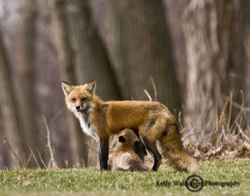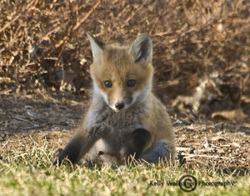KELLY WALKOTTEN PHOTOGRAPHY
|
I had the privilege of observing a fox family for a few days in the early April. The mom made her den near Lake Michigan at the top of a hill, in a heavily populated area. They are an attractive animal with a rusty reddish body, white underpants, chin, and throat, and a long bushy tail with a white tip. They have prominent pointed ears. The backs of ears, lower legs, and feet are black. The distinguishing feature which sets them apart from all other fox species is the white-tipped tail. Their average height is 15-16” tall, 35-41” long and weigh between 8 and 15 pounds.  The Red Fox is very sensitive to low-frequency sounds, which sets it apart from most other mammals. The fox listens for underground noises such as digging, gnawing, and the rustling of small animals. When he detects these sounds, he will dig frantically into the ground or snow to capture the animal. He stalks its prey much like a cat, by moving in as close as possible, then running down the prey when it bolts. The Red Fox will continue hunting even if he is full, burying excess food under snow, leaves, or soft dirt. He appears to find his cache by memory and smell, although other animals sometimes find the cache first, before it is retrieved by the Red Fox. An adult fox usually does not retire into a den in the winter but will curl into a ball in the open and wrap its bushy tail around his nose and foot pads. At times he is blanketed by snow while in this position. The Red Fox is very sensitive to low-frequency sounds, which sets it apart from most other mammals. The fox listens for underground noises such as digging, gnawing, and the rustling of small animals. When he detects these sounds, he will dig frantically into the ground or snow to capture the animal. He stalks its prey much like a cat, by moving in as close as possible, then running down the prey when it bolts. The Red Fox will continue hunting even if he is full, burying excess food under snow, leaves, or soft dirt. He appears to find his cache by memory and smell, although other animals sometimes find the cache first, before it is retrieved by the Red Fox. An adult fox usually does not retire into a den in the winter but will curl into a ball in the open and wrap its bushy tail around his nose and foot pads. At times he is blanketed by snow while in this position.  The maternity den is usually in sparse ground cover on a slight rise with a full view on all sides. It may also be on a stream bank, slope, rock pile, or the hollow of a tree log. The mail entrance is in an earthen mound, about 3’ wide with a mound of packed dirt. One to three less conspicuous escape holes are also built. This mother’s maternity den had one main entrance and five smaller escape holes. The den is well marked with excavated earth, cache mounds where they will bury their food, holes where food has been dug up, and scraps of bones, feathers, and fur. While there were four kits with the mother fox, a Red Fox will have from one to ten kits born in March to May. The kits are born in the maternity den after gestation of 51-53 days. When the kits are born, they already show the white tail tip. At about a month old, the young will play above ground, and will feed on whatever their parents will bring to them. Food is given by the mother to the first kit who begs for it. In years where food is scarce some young may die. At first the mom will predigest the meat and then regurgitate it but soon she will bring live prey, so the kits will learn and practice killing. Later the young hunt with their parents.  While there were four kits with the mother fox, a Red Fox will have from one to ten kits born in March to May. The kits are born in the maternity den after gestation of 51-53 days. When the kits are born, they already show the white tail tip. At about a month old, the young will play above ground, and will feed on whatever their parents will bring to them. Food is given by the mother to the first kit who begs for it. In years where food is scarce some young may die. At first the mom will predigest the meat and then regurgitate it but soon she will bring live prey, so the kits will learn and practice killing. Later the young hunt with their parents. Each of these four had distinctive personalities. One was aggressive, one playful, one followed the others around, and the fourth was shy and nervous, obviously the runt of the litter. In the early morning hours, mom would clean her kits, watch over them as they played, nurse them on demand, and produce rabbits and squirrels from a cache to feed her babies as well as herself. She would give them food and show them how to eat, tearing off meat for them and helping them to do it themselves. She kept a careful watch over them while I stayed back, but not hidden, and photographed as they went about their daily lives. The kits will fledge at about seven months. The males will travel away up to 150 miles, while the females usually will stay closer. The adults also disperse, remaining solitary until the next mating season.  The last morning I spent with them, mom approached me and scratched her head on a stick within three feet of me. She came close enough for me to pet, however I resisted, instead enjoying the close up photograph opportunities she gave to me. Later she brought one of her kits up close for a visit as well. Towards the end of the morning, I believe that mom had become so comfortable with me that she left the four kits and headed down the shoreline, presumably to hunt for food. She seemed convinced that I would not harm her babies and left the babies out with me. The babies played another half hour and then retired to the den for the day. The adult Red Fox has few enemies other than humans and cars but rabies, mange, and distemper can be a problem. For years unregulated trapping and bounty payments depleted the Red Fox population, but the collapse of the fur industry and the abolishment of most bounty payments have improved the fox numbers. Poultry farmers have made their farms predator-proof, so farmers are killing fewer foxes as well. The Red Fox seems to be spreading its range but competes with the Coyote which may have a restraining effect instead.
To be able to spend a few days with a Red Fox family, photographing their daily lives, was a privilege I will not soon forget. |
Categories
All
Kelly WalkottenI am a nature, wildlife and underwater photographer. I love to travel and capture the story. Archives
October 2020
Other Cool SitesHunts Photo is offering 10% off of all Red River Paper to my followers. I personally use and love Red River Paper!
|

